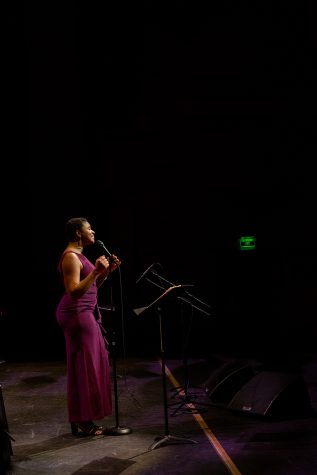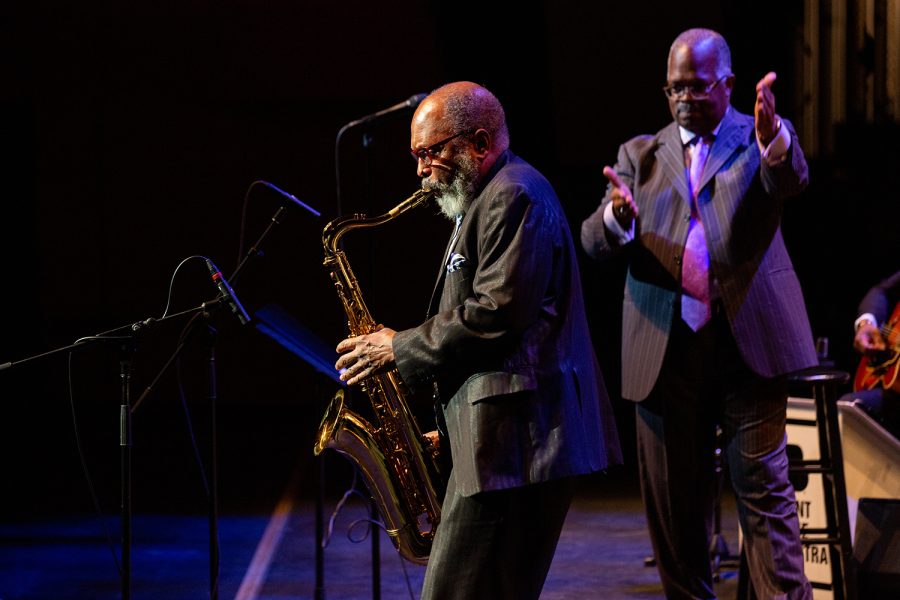Review: The Count Basie Jazz Orchestra featuring Lizz Wright at the Soraya
Edward Nenedzhyan, Reporter
December 7, 2021
The craft of live shows and touring acts across America is oftentimes underestimated, and can be one of the most difficult things for any musical group or artist to consistently accomplish.
If an artist’s endurance is measured in time, there are few musical acts with touring careers matching the longevity of the Count Basie Orchestra, which has entered its 86th year of touring.
“When you see a show like this, you see a showcase of American history,” said Thor Steingraber, the executive director of the Younes and Soraya Nazarian Center for the Performing Arts, as members of the jazz orchestra shuffled into their onstage seats, with brass and percussion at the ready.
Without hesitation the band launched into their opener, a rapidly-paced fanfare filled with groove and several Louisiana-inspired dirty trombone licks. The orchestra’s momentum was fiery, vouching for the idea that there’s no such thing as too many cooks in the kitchen. Every musician had their place throughout the entire show, which is a rare treat for fans of large ensemble jazz groups.

The first half of the show’s first act ran through a mix of jazz legend Count Basie’s original compositions and jazz-pop musician Quincy Jones’ arrangements, which felt like an appropriate starting point for the show given that the two musicians were instrumental in keeping the big band sound of the 1940s alive throughout the 20th century.
Midway through the first act, trumpeter and conductor Scotty Barnhart brought out gospel vocalist Lizz Wright for a collaborative set of reimagined Ella Fitzgerald jazz standards.
Fitzgerald’s three-octave vocal range made her one of the most unique voices in recorded musical history. Her contralto voice gave her the ability to hit some of the lowest notes biologically possible for a woman, a skill overshadowed by the glamour and shine of high notes and R&B.
Known for her similarly low-alto vocal range, Wright carefully sang Fitzgerald’s lowest and highest notes, an achievement that most female vocalists struggle with throughout their professional careers.
Wright’s gospel background and meek stage demeanor quickly turned her into the indisputable star of the show. Audience members fell silent, turned off their phones and fell under a shared trance the moment she began to sing.
The band returned to the stage after a brief intermission and presented a second act that almost exactly mirrored the first, with an instrumental first half and a vocal second.
The jazz orchestra’s instrumental performances were strong and charismatic, but the group truly hit its stride while sharing the stage with Wright and personifying the late Fitzgerald’s material, before performing an encore and concluding the evening’s performance.
The setlist covered several decades of the big band sound, across a wide variety of jazz, blues and gospel elements that blended together to showcase the swagger of Basie’s sound — but most importantly his attitude.
Rather than imitating Fitzgerald’s voice, Wright chose to perform to her own voice’s strengths, which gave a sense of confidence and showmanship that Fitzgerald herself embodied.
The show was a testament to an era of jazz that shaped the sound of America in the 20th century, and faithfully reaffirmed the legacy of the orchestra’s original bandleader, jazz legend Count Basie.

Read more at: Review: The Count Basie Jazz Orchestra featuring Lizz Wright at the Soraya – Daily Sundial (csun.edu)
